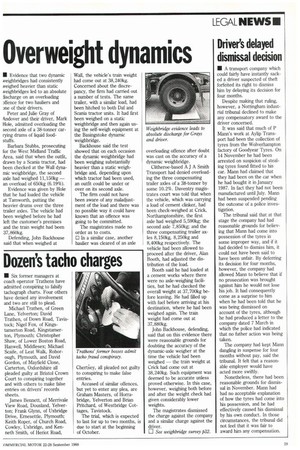Overweight dynamics
Page 13

If you've noticed an error in this article please click here to report it so we can fix it.
• Evidence that two dynamic Neighbridges had consistently Neighed heavier than static Neighbridges led to an absolute lischarge on an overloading )ffence for two hauliers and 3ne of their drivers.
Peter and Julie Gray of Andover and their driver, Mark Hole, admitted overloading the second axle of a 38-tonner carrying drums of liquid foodstuffs.
Barbara Stubbs, prosecuting for the West Midland Traffic Area, said that when the outfit, drawn by a Scania tractor, had been checked at the Wall dynamic weighbridge, the second axle had weighed 11,150kg — an overload of 650kg (6.19%).
Evidence was given by Hole that he had loaded the vehicle at Tamworth, putting the heavier drums over the three trailer axles. The vehicle had been weighed before he had left the customer's premises and the train weight had been 37,860kg.
Defending, John Backhouse said that when weighed at Wall, the vehicle's train weight had come out at 38,240kg. Concerned about the discrepancy, the firm had carried out a number of tests. The same trailer, with a similar load, had been hitched to both Daf and Scania tractor units. It had first been weighed on a static weighbridge and then again using the self-weigh equipment at the Basingstoke dynamic weighbridge.
Backhouse said the test showed that on each occasion the dynamic weighbridge had been weighing substantially heavier than a static weighbridge and, depending upon which tractor had been used, an outfit could be under or over on its second axle.
The firm could not have been aware of any maladjustment of the load and there was no possible way it could have known that an offence was going to be committed.
The magistrates made no order as to costs.
0 In a similar case, another haulier was cleared of an axle overloading offence after doubt was cast on the accuracy of a dynamic weighbridge.
Clitheroe-based A J A Smith Transport had denied overloading the three compensating trailer axles of a 38-tonner by some 10.2%. Daventry magistrates court was told that when the vehicle, which was carrying a load of cement clinker, had been check-weighed at Crick, Northamptonshire, the first axle had weighed 5,590kg; the second axle 7,850kg; and the three compensating trailer axles 8,150kg, 8,250kg and 8,400kg respectively. The vehicle had been allowed to proceed after the driver, Alan Booth, had adjusted the distribution of the load.
Booth said he had loaded at a cement works where there were no axle-weighing facilities, but he had checked the overall weight at 37,700kg before leaving. He had filled up with fuel before arriving at his destination, where he had been weighed again. The train weight had come out at 37,880kg.
John Backhouse, defending, said that on this evidence there were reasonable grounds for doubting the accuracy of the dynamic-axle weigher at the time the vehicle had been weighed — the train weight at Crick had come out at 38,240kg. Such equipment was deemed to be accurate unless proved otherwise. In this case, however, weighing both before and after the weight check had given considerably lower weights.
The magistrates dismissed the charge against the company and a similar charge against the driver.
See weighbridge survey p32.










































































